Introduction
Amazon is the leading global e-commerce company and deals with various products. It was established in 1995 by Jeff Bezos as an online book store (Sadq, Sabir and Saeed, 2018). The company expanded its boundaries and now deals with a variety of products such as toys, CDS, electronics, computer software, apparel, furniture, and many more. The company’s objective is to be the most customer-centric organization by meeting the needs of existing customers. With such goals, the organization needed to organize its activities so that customers could contact it, identify what they wanted, and obtain it quickly. The main aim of the company’s operation is on quality and efficiency. Thus, Amazon has worked hard to ensure that it performs effectively in the e-commerce sector.
Amazon’s mission, vision, and values have worked together and supported its goals and culture. Its mission shows its commitment to providing the best customer experience (Fox, 2020). The main points from the mission statement, as shown below, are customer-centric, find, discover and purchase online and lowest possible prices. The vision also shows that the company’s main objective is to ensure that customers are satisfied. Amazon’s vision is to become the most customer-centric company in the world (Fox, 2020). In addition, the company is guided by principles such as customer obsession, passion for innovation, commitment to operational excellence, and future-based thinking. Therefore, the company’s vision and mission statement provide direction that stakeholders are required to follow.
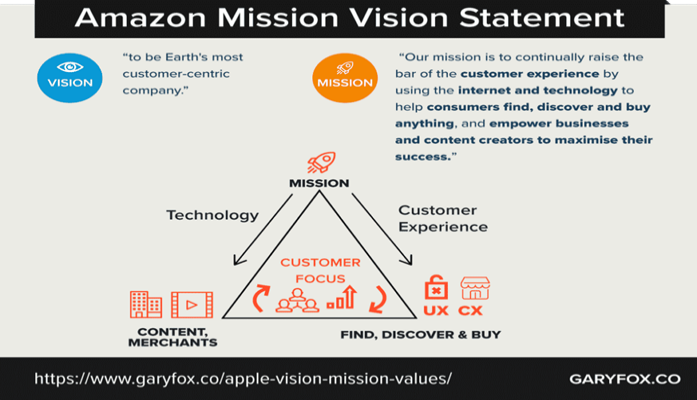
Amazon’s goal of layout design is to maximize the movement of people, resources, materials, and information. The company achieves this goal by employing effective layout strategies relating to computer-assisted processes (Almasi and Pratx, 2019). For instance, the products are organized based on computerization policy at the firm’s warehouses and fulfilment centers. In addition, the relevant structure integrates shelf space maximization to achieve optimal capacity without losing process efficiency in Amazon’s online retail (Almasi and Pratx, 2019). Therefore, the main intention of layout design to the organization is to achieve the anticipated efficiency and success.
Another goal of Amazon is to maximize operational output quality to match customers’ needs. Amazon’s operation management strategy in e-commerce involves continuous improvement attempts (Almasi and Pratx, 2019). The culture of the firm encourages people to generate new ideas. For instance, Amazon encourages employees to be brave and imaginative in solving challenges and improving the company’s operations. Based on this, the ideas generated have ensured that the company remains ahead of its competitors in the market. The new ideas are focused on solving issues within and outside the business environment. Thus, Amazon ensures that its customers get quality products and services.
The Operations Management Processes and Quality Management Processes
Quality Management
Amazon’s success in quality management is due to its open communication approach. According to Alshmrani (2021), one of the company’s problems is making sure that the products that a customer gets meet their needs and the services provided are excellent. As a short-term solution, the company has passed the legal responsibility of ensuring the products are of desired quality to sellers. The company also conducts quality inspections on the products to ensure quality standards. As a long-term solution, the company encourages employees to question the existing quo, propose new ideas, and be creative and innovative (Alshmrani, 2021). By doing so, Amazon has improved its efforts in the e-commerce market and has greatly increased its operational production to satisfy its clients by exceeding their expectations.
Process Design
The main issue of any contemporary organization would be to optimize its operations process and capacity. Ramadan, Farah and Kassab (2019) posit that Amazon’s problem is to keep up with a spike in online orders. The long and short term solution to the problem was to optimize its business procedures. The company adopted the most advanced and complex methods available. Because online retail services are Amazon’s principal product, billions of dollars have been invested in upgrading and purchasing new technologies and automating operations. Given that the mail service is mostly used for online retail, Amazon has automated the ordering procedure to complete numerous orders (Ramadan, Farah and Kassab, 2019). As a result, the company can now handle multiple orders through advanced technology.
Layout and Location Design
Location and layout are among the factors that affect the performance of an organization, especially in the area of accessibility. Dekhne et al. (2019) state that Amazon’s problems are the accessibility of its services and commodities to customers. To solve this issue, Amazon has opened stores in various locations with the greatest number of clients. One of the findings of Dekhne and other authors was that the company has established stores and warehouses to generate more money. A good example is the presence of physical Amazon book stores in the US. The strategy ensures that customers do not shop elsewhere and that Amazon is within reach. The company has also designed its website to perform operations required to purchase a product. Thus, Amazon has successfully worked to ensure that all barriers to accessibility to its products are eliminated.
Moreover, Amazon has ensured that the layout of its assets is designed so that human resources, goods, and information can be transferred easily. Chaffey, Edmundson-Bird, and Hemphill (2019) believe that Amazon achieved a proper layout by integrating the layout with machine-assisted processes, considering that robots are more helpful in managing a 24-hour process. As a result, a consumer can place an order from any location. The ideas of Amazon include maximizing shelf space and minimizing lanes to achieve maximum capacity without jeopardizing productivity and profitability (Khan, 2019). Therefore, integrating technology in its operations has helped Amazon achieve the anticipated objective of increasing customer satisfaction.
Supply Chain Management
The supply chain is without a doubt one of the undeniable operational processes that require a smooth operation. Chaffey, Edmundson-Bird, and Hemphill (2019) posit that one of the challenges facing Amazon’s supply chain is the failure of customers to get their orders as planned, especially during busy shopping seasons. To solve the problem, Amazon ensures that the supply chain is flawless because this is a platform where both clients and providers can participate. Amazon has successfully purchased the technology that automates and allows suppliers and buyers to view its data concurrently (Chaffey, Edmundson-Bird, and Hemphill, 2019). For example, customers can also track their orders and contact suppliers and the Amazon team using the data provided on the Amazon website. In addition, for the future, the company has invested in innovation to generate new ideas for upgrading the supply chain. As a result, Amazon’s supply chain is undoubtedly among the most efficient in the world.
Inventory Management
Amazon requires fast inventory updates, physical counts, and just-in-time processing products as online retail. However, Kawa (2017) claims that one of the issues affecting Amazon’s supply chain is maintaining increased order volumes. For a long-term solution, Amazon has implemented a method in which its warehouse personnel are trained to optimize order fulfilment through mobile computer systems (Kawa, 2017). The goal is to keep finished goods on hand as long as possible while maintaining appropriate inventory ordering. Amazon also established an effective and open communication channel with stakeholders as a current solution. As a result, customers can track the movement of their products. This strategy improves its online retail inventory quantity while lowering costs and successfully catering to market demand.
Innovation
Innovation is a concept that has enhanced Amazon’s dependability and stability. According to Hong, Nam and Kim (2020), Amazon is faced with constant disruption and intense competition in the e-commerce industry. As a solution, Amazon has made sure a highly qualified team is in charge of preserving technological assets. In addition, the company has ensured that its employees are periodically trained to preserve their human capacity to meet their e-commerce business needs. More specifically, Amazon is on the lookout for breakthroughs and cutting-edge technologies to help them increase its operating efficiency (Hong, Nam and Kim, 2020). The company has also bought technological assets to ensure that its processes align with its future forecasts. Thus, the company is keen on making sure they constantly innovate to enhance the efficiency of operations.
Operations Management Tools
The Pareto Principle
A Pareto principle is an important tool in managing operations in an organization. It is also known as the Pareto rule or 80/20 rule. The principle shows that the relationship between outputs and inputs is not balanced. Amazon uses the 80/20 rule to influence its decision-making approach (Russell, 2019). For example, for effective product selection, Amazon uses 80% of data collection and 20% of the experience to achieve its objectives. Amazon approaches product selection in all categories, from electronics to fashion to garden equipment, in the same way, it approaches all decisions (Russell, 2019). The company does selection by emphasizing data over human factors. The principle has enabled Amazon to make informed decisions, which has influenced its success.
The principle also means that if an organization exerts 20% of input, it can attain 80% output. Amazon has been working hard to understand its customers to perform effectively (Russell, 2019). The company’s strategy is to focus on meeting the customers’ needs in the market. For example, Amazon ensures that the customers obtain quality products within the specified timeline. In addition, they have a customer care that works 24/7 to address customers’ concerns. The input outcome is evident in Amazon’s revenue over the years. In 2021, the company had a revenue of about $457 billion, a 31% increase from 2020 (Macro Trends, 2022). Therefore, the focus on customers contributed to high income for Amazon.
Fishbone Diagram
Fishbone diagrams can help an organization to generate and group ideas as well as discover potential sources of an issue. As shown in the figure below, the diagram is a graphical depiction of cause and effect. It is a more systematic technique for brainstorming the source of a problem than other tools. The issue or consequence is seen at the fish’s head or mouth (Kudla and Brook, 2018). Potential contributing factors are listed under various cause categories on the smaller bones. A fishbone diagram can assist identify feasible explanations for a problem that might not otherwise be investigated by directing the team to look at the categories and think of alternate causes.
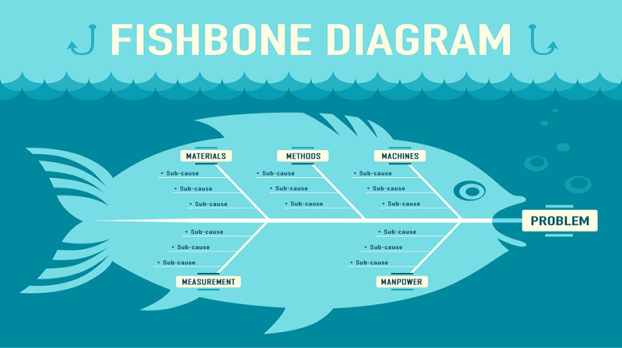
Materials
Amazon’s material-based issues include product unavailability, cost, and category constraints. Many customers were reported to visit the website and then leave after a quick search. After compiling the data with the help of a third party, Amazon recognized that the reason customers were departing and searching for another organization to suit their needs was simply a lack of quantity (Lu, 2019). As a result, more organized and well-equipped facilities were built worldwide. It was also discovered that the cost and quality were not standard. The items were shipped to address the issues and provide a long-term solution. This reduced the cost of storage, which reduced the cost of goods. A team of inspectors ensures that the quality is consistent.
Methods
Amazon, like any other multinational corporation, is a target for fraudsters. Several fraud cases have been revealed, and Amazon has taken some major steps to address the issues (Button and Cross, 2017). One example is the establishment of an Amazon fraud detector. Because Amazon has one of the largest customer databases, managing, protecting, and maintaining the database was critical. Amazon has also invested in cutting-edge technology to handle its data, customer information, and information technology (Button and Cross, 2017). In addition, the company has ensured that its policies with its millions of third-party merchants and suppliers worldwide are supplier-friendly, business-focused, and mutually beneficial. Therefore, the methods adopted helped in addressing the problem of fraud.
Man-power
Man-power is crucial in data entry, training and promoting efficiency of operations in Amazon. Because human resources play a critical role in maintaining and inserting important data and information into the system, it was discovered that many entries might be improved (Lu, 2019). As a result, the company was determined to train its employees and expose the processes to challenge intensively. The new ideas and perspectives were welcomed because they were integral in solving the challenges experienced. The shift in policy toward human resources has helped to ensure that other processes are running smoothly. However, the controllable operations in the organization are still in the hands of the operations’ manager and team (Lu, 2019). Therefore, Amazon is keen on making sure that human resources have the required skills to perform its operations effectively.
Machines
A machine is at the core of Amazon’s functions, operations, products and services. At Amazon, the machines are upgraded to ensure that processors and robots can learn and communicate effectively (Barro and Davenport, 2019). More modern technology, such as robot arms in the warehouse handling pallets, has replaced manual machinery shortage. In addition, the company began to focus on long-term goals and beneficiaries, such as electric automobiles and delivery drones. The company has also built a global network of machines that communicate, improving consumers’ experiences.
Measurements
Measurement-based issues that can adversely affect Amazon are wrong forecasting, time consumption and manual checklists. Wrong forecasting leads to poor business decisions and can cause catastrophic results such as lost sales or inflated inventory (Laber, Thamma and Kirby, 2020). Manual checklists can result in a myriad of problems in Amazon. Based on this, the company took up room for filing, which took up a lot of time, lowering production and hurting the company’s profitability. For example, computer-controlled robots were installed, which accurately log the actions in real-time. This provided the employees more time to focus on operations and be more productive (Laber, Thamma and Kirby, 2020). The company could handle a number of problems and enhance earnings by changing one method.
Lean Manufacturing
Amazon’s success is primarily due to its focus on offering its customers the greatest possible shopping experience. The company is aware that clients will not pay for waste and that waste prevention is a core concept of lean management (Yamamoto and Lloyd, 2019). In a world that is becoming faster and more efficient by the day, the firm understands that waste management is also critical to success. Following this mentality, Amazon has learned to focus solely on themes directly relevant to customers’ needs. As a result, the customer’s guaranteed delivery date has the greatest influence on the mode of transportation chosen for a given shipment (Yamamoto and Lloyd, 2019). Likewise, lower-cost alternatives are evaluated only if they have a comparable possibility of being delivered on time.
Following Amazon’s transformation from a bookstore to a worldwide shopping mall, they reconsider automation. The organization follows the lean philosophy of autonomy, which includes keeping humans for high-value and complex work and using robots to assist with assigned duties (Yamamoto and Lloyd, 2019). The procedure also entails delegating simple repetitive work to robots and deploying personnel in required areas. As a result, Amazon creates work opportunities that give people real challenges and satisfaction. At the same time, autonomation aids humans in performing duties in a defect-free and safe manner by automating only the basic, repetitive, and low-value operations (Yamamoto and Lloyd, 2019). The principle of automation has helped improve the efficiency of Amazon’s operations.
Amazon has amassed an amazing logistical infrastructure in warehouses known as fulfilment Centers. The massive centers, which average one million square feet, maximize inventory management efficiency (Knight, 2021). The physical and informational process at Amazon starts with inbounding when products are placed on a conveyor belt. A computer algorithm is used to unload, scan, position products in carts, and sort them into shelves, as indicated in the figure below. Kiva robots use sensors to navigate the warehouse and move shelves to staff (Knight, 2021). Employees use computer systems to find and pick products from shelves, then place them on the conveyor for packing. The company has captured immense value through its automated warehouses.
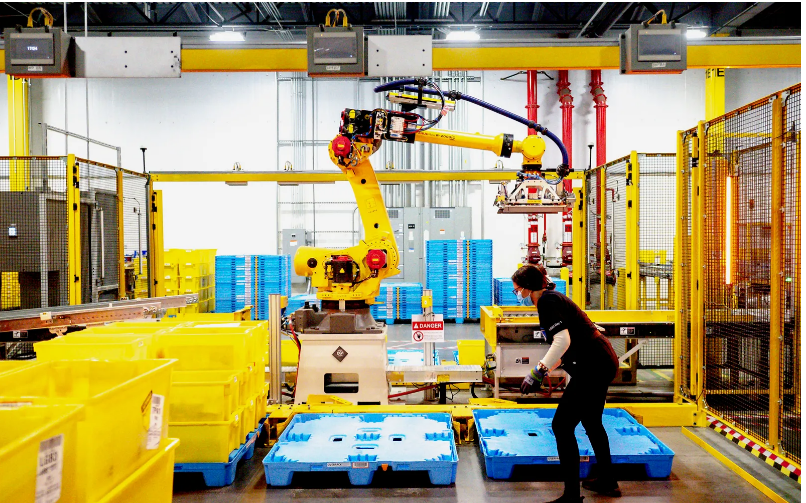
The Six Sigma Technique
Six sigma is a known paradigm in the manufacturing industry. It helps management in various ways, such as total management commitment, the concept of excellence, customer focus, process improvement, and the rule of measurement rather than gut feel (Ahmed, 2019). The idea is to improve every part of the organization’s ability to meet evolving consumer, market, and technology needs. However, six sigma has various disadvantages, like being time demanding and needing professional labor, and some critics argue that Six sigma offers nothing new (Ahmed, 2019). As a result, the benefits of six sigma outweigh the drawbacks, making it an appropriate technique for process development.
Amazon is one of the companies that use the six sigma concept. Although Amazon is not a manufacturing company, the six sigma is everywhere in the organization (Pierce and Dalal, 2019). As shown in the figure below, businesses use this quality control process to get rid of defects and improve operations. The concept exists to improve the quality of a process output through the identification and elimination of defects in an organization. For example, at Amazon, employees are trained to use sigma to increase the efficiency of its operations (Sharma, 2017). It is an improvement approach to inspire everyone to find better ways to do things, resulting in an environment geared toward innovation. Therefore, Amazon employs lean six sigma throughout the organization, which remains a core practice.
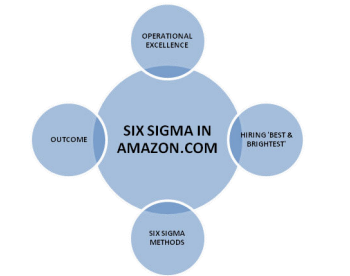
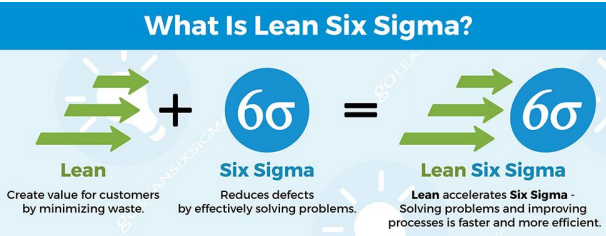
How Information Management System Enhances Overall Business Operations
The information management system has helped Amazon handle its transactions. For a customer to order a product at Amazon, they are required to have a profile on Amazon.com. The company provides many features to personalize its profile with web tools such as a shopping cart and wish list (Ross, Beath, and Mocker, 2019). Amazon has a system that enables one-click ordering, a personalized shopping experience, and easy to use card transactions. Customers with active functionality can order by clicking one button without filling order form. For secure transactions, the company use secured server software. A customer’s personal information is encrypted to secure information through the internet.
Amazon web service is a cloud platform provided by Amazon. The platform is the main profit driver to the company because it provides servers, storage, remote computing, email, mobile development, and security (Ross, Beath, and Mocker, 2019). In addition, customers can utilize the online service to create user accounts and personalize their profiles in order to improve transaction processing efficiency. Amazon web service comprises numerous systems with diverse functionalities that improve information management and business process delivery efficiency. As a result, the system is incredibly advanced to promote high levels of interoperability with any form of internet-enabled device, allowing for efficient communication between customers, vendors, and Amazon personnel.
Customer relationship management (CRM) is one of the reasons behind effective customer service at Amazon. The company created its CRM software in-house, tailored to its specific needs and wants. For example, Amazon’s software may encapsulate consumer data such as previous purchases and location and utilize it to instantly change and adapt a user’s overall on-site experience (Ross, Beath, and Mocker, 2019). Amazon’s CRM also handles the vast majority of customer inquiries before requiring human participation. For example, each consumer may easily see their purchase history, allowing them to know what they ordered, where they are in the delivery process, and how much they have used. As a result, CRM is an information management system that has helped Amazon improve its customer service.
The Role of ICT Applications in Operations Optimization
One of the ICT applications used in Amazon is the Amazon Go application. A customer can utilize the application to enter the stores and shop (Ross, Beath, and Mocker, 2019). With this application, the products selected from the shelves are automatically added to the virtual carts of the clients. As a result, customers freely walk out of the stores with their accounts electronically charged and a receipt supplied from the device. Amazon Go’s technology combines computer vision, machine learning, artificial intelligence and sensor fusion technologies. Because Amazon does not accept cash for purchases made in its stores, this technique allows it to reduce fraud.
The other ICT application used by Amazon is the supplier database. It is an application that connects Amazon’s customers with suppliers. The database is a first-of-its-kind that assists customers in finding legitimate suppliers (Ross, Beath, and Mocker, 2019). The application helps manage purchase orders, compare supplier quotes, and track contact information. For example, once a customer has agreed with the supplier on the details of their supplier, they can generate orders using a supplier tracker to keep a record of their financial transactions. Amazon can also use the application to learn more about suppliers and their products in the market. With this information, the company can determine whether there is a need for new products and services on offer to explore opportunities.
How AI Can Enhance the Overall Business Operations of the Organization
Amazon has been transformed by artificial intelligence to be one of the most successful corporations in the world, both locally and internationally. Amazon has gone to the top of the list of the world’s wealthiest corporations by doing everything from labelling things to managing inventories, packaging, and shipping to monitoring customers, comprehending them and predicting their wants and expectations (Ross, Beath, and Mocker, 2019). The use of artificial intelligence in Amazon Go demonstrates how successful a corporation can be by using artificial intelligence to learn and predict client wants. Amazon Go appears to work in a pretty straightforward manner. Its intellect, on the other hand, is extremely smart and precise. As a result, automated stores have virtually no fraud cases and are far safer than conventional businesses.
Amazon can use artificial intelligence to promote the physical shopping experience. Recently, the company added brick and mortar Amazon Go stores where customers can walk in, shop and walk out without going through checkout or using cash or credit card (Ross, Beath, and Mocker, 2019). The operation uses face recognition integrated with machine learning to work effectively. Artificial intelligence will direct a customer to the nearest and most accessible business that carries the exact product they want to see. The system then comprehends and concludes what the customer desires, displaying the results. Therefore, the operation saves the customer time and improves the purchasing experience.
Amazon can also apply artificial intelligence in managing its international operations. Artificial intelligence is immensely beneficial and productive because it collects and analyzes shopping trends from many cultures, regions, and nations (Ross, Beath, and Mocker, 2019). In addition, the information is distributed in real-time to various locations, appropriate suppliers, stores, and warehouses. This expedites the process and assures that the consumer finds what they are looking for while allowing retailers to update and maintain inventory in real-time. The information is then instantly transmitted to the customer. As a result, Amazon can use artificial intelligence to manage data while operating in a global arena.
The Challenges That Amazon May Experience
There are challenges that Amazon may experience in using artificial intelligence. First, the company can find it hard to integrate artificial intelligence systems with the existing information systems leading to delays and increased cost (Yamamoto and Lloyd, 2019). Therefore, the employees should be equipped with artificial intelligence through training and support. Second, Amazon may experience a challenge in managing and identifying data quality and suitable data sets. Additionally, cybersecurity professionals are becoming more concerned with artificial intelligence attacks. Based on this, Amazon is required to set up measures to counter any potential security threat when using artificial intelligence (Yamamoto and Lloyd, 2019). Therefore, the company is expected to consider the challenges when using artificial intelligence.
Conclusion and Recommendations
Amazon has risen to become one of the world’s strongest and richest companies due to its focus on meeting the needs of its customers and operational efficiency. The company did not hesitate to try new approaches, encouraging employees to challenge existing methods in order to improve services. The authorities were delegated based on seniority to guarantee that the right person makes the appropriate choice at the right time. Moreover, many modern improvements were implemented to achieve operational efficiency. The company’s investment in contemporary machines and technology is one of the primary aspects contributing to its success. Therefore, the company majors on automating its operations to ensure that customers are satisfied.
There are various recommendations that Amazon can consider to enhance its operations and continue performing effectively in the market. Amazon should implement strong defenses against cyber-attacks through a skilled and experienced cyber-security workforce. The company should consider training its employees to enhance artificial intelligence security. Amazon should also use artificial intelligence to enhance decision-making processes, integrate, and streamline its operations. The company’s decision should be informed by the data collected through artificial intelligence. In addition, Amazon should continue with the strategy of striving to meet customers’ needs. Therefore, these recommendations are integral for Amazon because they will ensure that they achieve the intended objective.
Develop A Project Network Diagram
A project network diagram is an important concept in project management because it is the foundation of the schedule and allows a project team to allocate resources. It links activities that indicate all project tasks, duration, and logical relations in a project. In other words, a network diagram is a vital visualization of the sequence and logical interconnections of tasks in a project. The schedule consists of nodes representing activities and arrows indicating the sequence and dependencies of tasks. The diagram is normally used to develop and document the sequence of project activities. In addition, an individual can use the diagram to discuss sequence and relationships and stakeholder communication in a project. Therefore, it is important to understand the relationships between activities and their impact on sequencing in a project.
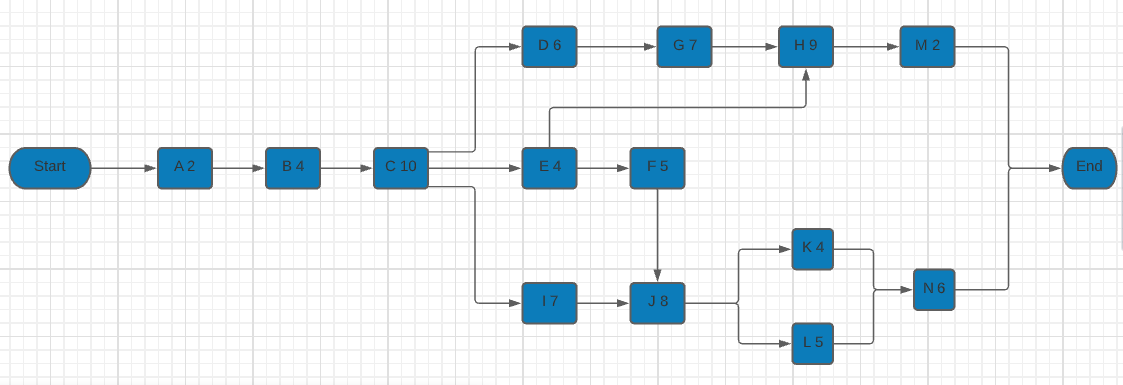
The first three tasks represented in the diagram are A, B and C. A is the first activity, which should be completed within two weeks. Apart from the start function, the task has no predecessor. B is the second activity and should be completed within four weeks. In this activity, the predecessor is A, meaning that B can only start after the completion of task A. Finally, as shown in the diagram, C is the third activity, completed within ten weeks. At this node, the predecessor is B, meaning that C cannot start before the completion of B. Therefore, the three activities are among the initial tasks that the project team should start with and ensure that they are completed chronologically.
D, E and I are the three separate activities that start after C’s completion. The three activities take different paths, meaning that they can run simultaneously. The fourth activity is D, which should be completed within six weeks. Because C is its predecessor, the activity cannot start before its completion. The fifth activity is E and ought to be completed in four weeks. The predecessor for E is C, which means that it cannot start before C is completed. E is separated into two activities, namely F and H. From C, the sixth activity is I, which should be completed in seven weeks. The activity I cannot start before the completion of C.
One of the activities that come after the completion of C is D and E. From D, the seventh activity to be undertaken is G. From the information provided, the activity should be completed within seven weeks. The two separate activities are H and F, with E as their predecessor. Based on this, the eighth activity is F and is supposed to be completed in five weeks. Finally, from activities E and G, the ninth task to be completed in nine weeks is H. As shown in the diagram, H cannot start before the completion of G and E. Therefore, these activities should be completed in their order and within the set timeline.
There are some activities that come after the completion of F and I. J is considered the 10th activity and should be finished within eight weeks. The predecessors are F and I, meaning that J cannot start before completion. From H, the 11th activity is M, which should be completed in two weeks. As shown in the diagram, M is one of the last activities of the project. In addition, J is divided into two activities identified as K and L. The 12th activity is K, which should be completed in four weeks, while the 13th activity is L, to be completed in five weeks. Finally, the 14th task is N and should culminate within six weeks. Like M, N is the final task for the project.
Project Schedule Using Critical Path Method
The critical path method is a technique that enables a project team to determine tasks required to complete a project. It is the longest sequence of activities that must be completed within the set timeline to finish the project. The technique maps key tasks or critical tasks appropriate for completing a project. It makes it easy to schedule project activities that are not on the critical path and allocate resources more effectively. It also enables a project team to understand where they need to focus their time and energy. Based on this, a project team needs to determine the critical path of a project.
The Critical Path of ABC Construction Company
ABC construction has many paths to follow to complete the project. However, since the critical path is the longest sequence of activities. As a result, the critical path as shown below is A, B, C, E, F, J, L and N. With this path, it is expected that the project team should take 44 weeks to complete the project. It includes activities such as excavating, laying the foundation, putting up a rough wall, installing exterior plumbing, installing interior plumbing, placing the wallboard, interior painting, and interior fixtures. Therefore, the identified critical path informs the project team on the possible direction of the project and the duration for completing the project.
Reference List
Ahmed, S. (2019) ‘Integrating DMAIC approach of Lean Six Sigma and theory of constraints toward quality improvement in healthcare’, Reviews on Environmental Health, 34(4), pp. 427-434. Web.
Almasi, S. and Pratx, G. (2019) ‘Cloud computing for big data’, in Deng, J. and Xing, L. (eds.) Big data in radiation oncology. Boca Raton: CRC Press, pp. 61-78.
Alshmrani, H.M. (2021) ‘An analytical view of amazon success in the worldwide’, Life Science Journal, 18(6). Web.
Barro, S. and Davenport, T.H. (2019) ‘People and machines: partners in innovation’, MIT Sloan Management Review, 60(4), pp. 22-28. Web.
Button, M. and Cross, C. (2017) Cyber frauds, scams and their victims. London: Routledge.
Chaffey, D., Edmundson-Bird, D. and Hemphill, T. (2019) Digital business and e-commerce management. Harlow: Pearson UK.
Dekhne, A. et al. (2019) Automation in logistics: big opportunity, bigger uncertainty. Web.
Fox, G. (2020) Amazon mission statement: an analysis. Web.
Hong, A., Nam, C. and Kim, S. (2020) ‘What will be the possible barriers to consumers’ adoption of smart home services?’, Telecommunications Policy, 44(2), p. 101867. Web.
Kawa, A. (2017) ‘Fulfillment service in e-commerce logistics’, Log Forum, 13(4). Web.
Khan, L.M. (2019) ‘The separation of platforms and commerce’, Columbia Law Review, 119(4), pp. 973-1098. Web.
Knight, W. (2021) Robots won’t close the warehouse worker gap anytime soon. Web.
Kudla, A.U. and Brook, O.R. (2018) ‘Quality and efficiency improvement tools for every radiologist’, Academic radiology, 25(6), pp. 757-766. Web.
Laber, J., Thamma, R. and Kirby, E.D. (2020) ‘The impact of warehouse automation in amazon’s success’, International Journal of Innovative Science, Engineering & Technology, 7(8), pp. 63-70. Web.
Lu, Y., (2019) ‘Artificial intelligence: a survey on evolution, models, applications and future trends’, Journal of Management Analytics, 6(1), pp. 1-29. Web.
Macro Trends. (2022) Amazon Revenue 2006–2021 | AMZN. Web.
Pierce, S. and Dalal, D. (2019) ‘Leaning on a hybrid approach: A case for Lean Six Sigma’, Industrial and Organizational Psychology, 12(3), pp. 247-250. Web.
Ramadan, Z.B., Farah, M.F. and Kassab, D. (2019) ‘Amazon’s approach to consumers’ usage of the Dash button and its effect on purchase decision involvement in the US market’, Journal of Retailing and Consumer Services, 47, pp. 133-139. Web.
Ross, J.W., Beath, CM and Mocker, M. (2019) Designed for digital: How to architect your business for sustained success. Cambridge: MIT Press.
Russell, C., (2019) ‘Amazon – redefining the 80:20 rule’, Forbes, Web.
Sadq, Z.M., Sabir, H.N. and Saeed, V.S.H. (2018) ‘Analyzing the Amazon success strategies’, Journal of Process Management. New Technologies, 6(4). Web.
Sharma, P. (2017) ‘Six Sigma-A Case Study of Amazon.Com’, International Journal of Research in Management, Economics and Commerce, 7(8), pp. 131-135. Web.
Yamamoto, K. and Lloyd, R.A. (2019) ‘The role of big data and digitization in Just-In-Time (JIT) information feeding and marketing’, American Journal of Management, 19(2), pp. 126-133. Web.
